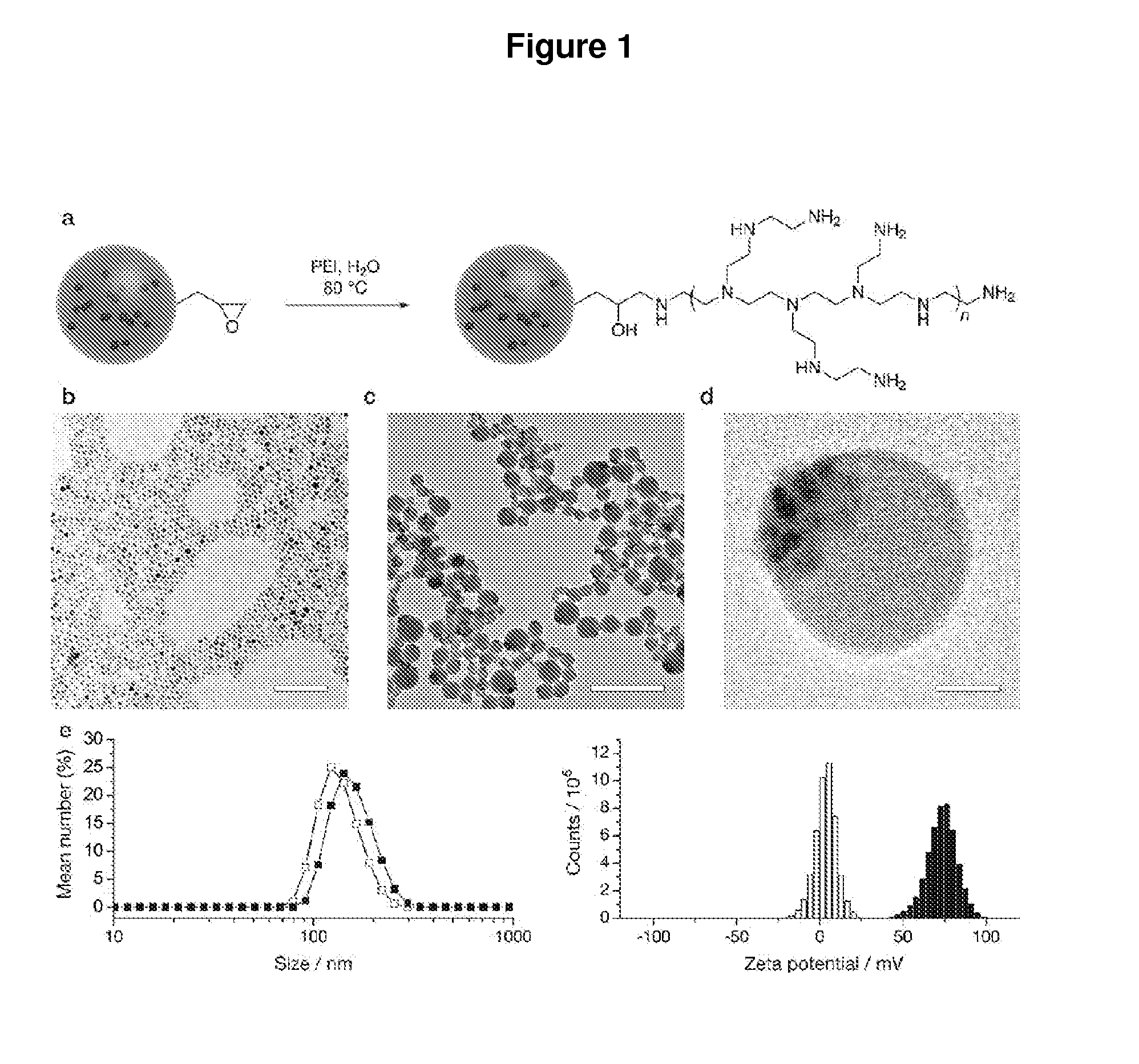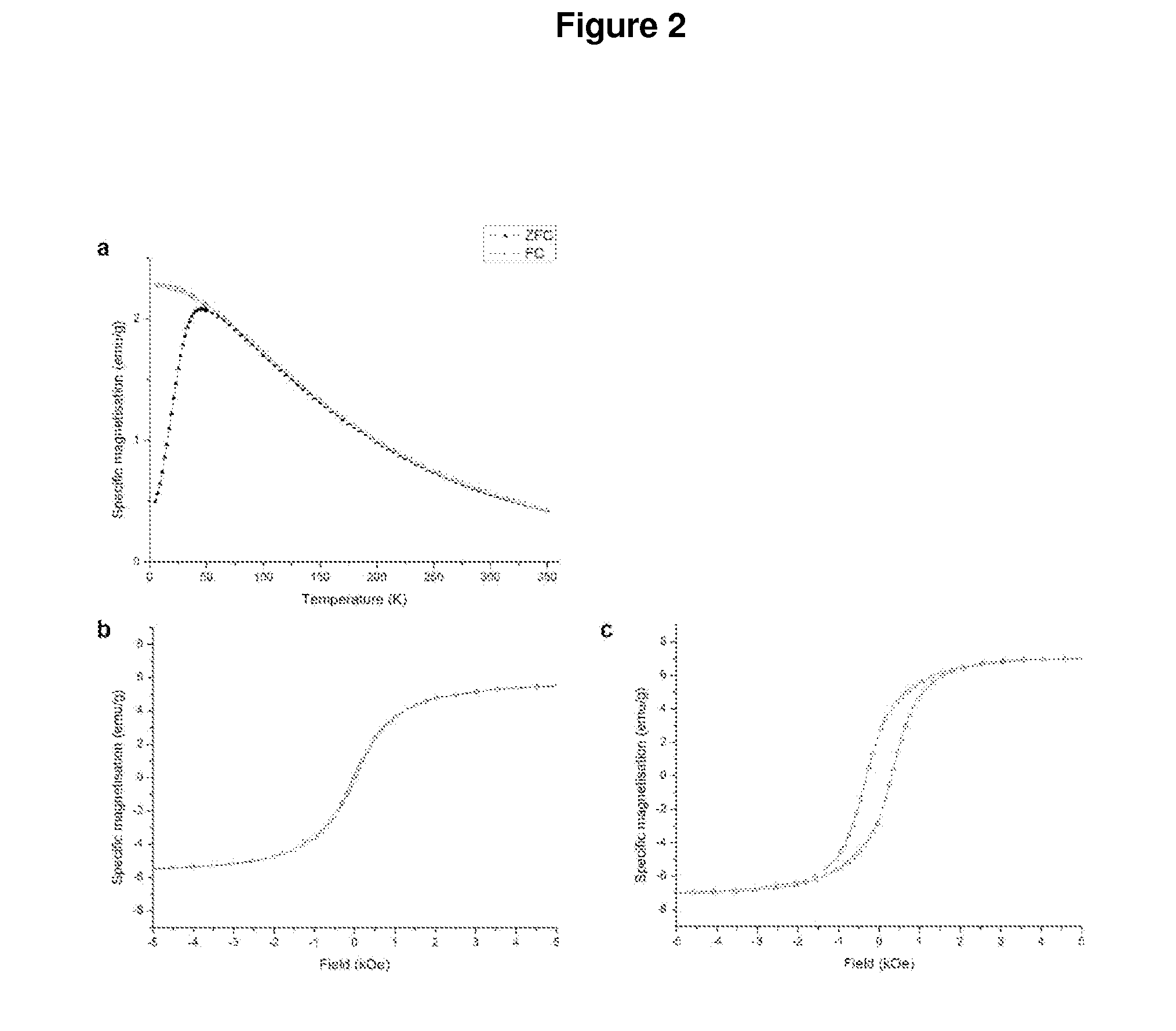Multifunctional nanoparticles
a nanoparticle, multi-functional technology, applied in the direction of powder delivery, energy modified materials, drug compositions, etc., can solve the problems of limiting their broad clinical application, and achieve the effect of reducing the problem of toxicity
- Summary
- Abstract
- Description
- Claims
- Application Information
AI Technical Summary
Benefits of technology
Problems solved by technology
Method used
Image
Examples
example 1
Preparation and Characterisation of Nanoparticles of the Invention
Results and Discussion
Preparation of Nanospheres by Covalent Reactions and Non-Spontaneous Emulsification
[0082]The preparation of magnetofluorescent polymer nanospheres used iron oxide nanoparticles synthesised by high temperature decomposition (FIG. 1b) and preformed polymers. Although electrostatic attraction may be employed in nanoparticle synthesis, such binding is reversible with the chance that imaging moieties may escape. Thus, it was preferable to attach surface modifying agents and dyes by covalent bonds. PGMA is a lipophilic polymer whose epoxide groups are reactive towards various nucleophiles, so covalent attachment to the polymer was possible by means of a simple ring-opening reaction. Because the majority of reactive epoxide groups would be inaccessible after forming nanospheres, RhB may be attached to the polymer in a solution-phase reaction. RhB is a xanthene dye that contains a reactive carboxylic aci...
example 2
Intracellular Release of a Calcium Channel Blocker from Multimodal Nanoparticles
Results and Discussion
[0129]Protecting vulnerable neurons and glia from damage that occurs secondary to neurotrauma is one of several requirements for successful therapy. Deregulation of calcium ion homeostasis is associated with secondary degeneration and release of excitatory amino acids, initiating cascades that lead to increased mitochondrial production of reactive oxygen species and cell death. Calcium channel blockers have been shown to prevent calcium influx in vitro and protect against secondary injury effects in vivo. In this work, lomerizine, a calcium channel blocker with limited aqueous solubility, was encapsulated in multifunctional polymer nanospheres. The protective effect of lomerizine, that is, preventing calcium influx, was demonstrated by measuring the intracellular calcium concentration in PC12 cells exposed to glutamate. The results show that targeted intracellular delivery of lomeri...
example 3
Regression of Autochthonous Tumours of Breast and Colon: Biological drug delivery using multimodal nanoparticles
[0145]A multimodal nanoparticle (PEINP) of the invention which has: a supramagnetic core; highly positively charged PEI branches; and showed high efficiency of transfection of shRNAs, small oligos and miRNAs, was investigated under in vitro and in vivo conditions. PEI based nanoparticles are linked with rhodamine for the purpose of confocal imaging and visualization of these nanoparticles. The applicant further showed that a functional gene c-myc shRNA loaded on the nanoparticles were delivered to their appropriate autochthonous tumour sites, could help tumour regression effectively. The hyperthermia produced by the supramagnetic core helped in increased transfection efficacy and efficient drug delivery to the tumour necrotic core.
Results
Synthesis and Characterization of Multimodal Nanoparticles
[0146]It is often essential to deliver a larger or a smaller molecule capable o...
PUM
| Property | Measurement | Unit |
|---|---|---|
| confocal time-lapse | aaaaa | aaaaa |
| confocal time-lapse | aaaaa | aaaaa |
| confocal time-lapse | aaaaa | aaaaa |
Abstract
Description
Claims
Application Information
 Login to View More
Login to View More - R&D
- Intellectual Property
- Life Sciences
- Materials
- Tech Scout
- Unparalleled Data Quality
- Higher Quality Content
- 60% Fewer Hallucinations
Browse by: Latest US Patents, China's latest patents, Technical Efficacy Thesaurus, Application Domain, Technology Topic, Popular Technical Reports.
© 2025 PatSnap. All rights reserved.Legal|Privacy policy|Modern Slavery Act Transparency Statement|Sitemap|About US| Contact US: help@patsnap.com



